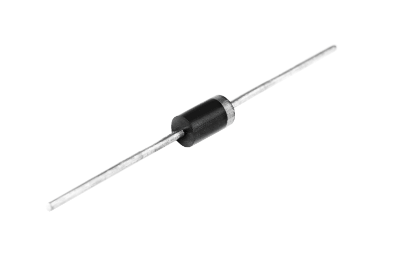What Is a Diode Rectifier?
 A diode rectifier is a semiconductor device that rectifies the alternating current of a commercial power supply in a power circuit to obtain a pulsating current.
A diode rectifier is a semiconductor device that rectifies the alternating current of a commercial power supply in a power circuit to obtain a pulsating current.
Compared to ordinary small-signal diodes, rectifier diodes are characterized by their large size, high current capability, high withstand voltage, and robust structure. Bipolar tubes, which are vacuum tubes, are also called diodes and were once widely used as rectifiers, but since they are now limited to special applications, this paper is limited to semiconductor elements.
Uses of Diode Rectifiers
Diode rectifiers are always used in the rectifier circuits of power supplies that produce DC power from commercial power sources. In circuits that rectify high-frequency alternating current, such as switching regulators, fast recovery diodes with short reverse recovery times and Schottky barrier diodes with low losses are used, which are also considered to be a type of rectifier diode.
Principle of Diode Rectifiers
In a diode rectifier, the P-type terminal side is called the anode and the N-type terminal side is called the cathode, and near the PN junction, N-type electrons and P-type holes cancel each other out, creating a depletion layer. When a forward voltage is applied between anode and cathode, holes are injected into the P-type area and electrons into the N-type area, thus narrowing the depletion layer and allowing current to flow from P-type to N-type.
When a reverse voltage is applied, electrons are injected into the P-type area and holes into the N-type area, causing the depletion layer to expand and no current to flow. This indicates that in a diode, current flows only in the P-type to N-type direction. From the above, when an alternating voltage is applied from the anode to the cathode of a diode, current flows only in the forward direction, and no current flows in the reverse direction. This is the principle of rectification.
A rectifier diode by itself is a half-wave rectifier, and current is output for only half a cycle of alternating current. On the other hand, a bridge connection using four diodes results in full-wave rectification, which has the advantage of providing a large current and reducing ripple, so diodes connected in a bridge are commonly used.
Types of Diode Rectifiers
There are three main types of diode rectifiers:
1. Silicon Diodes
This is one of the most widely distributed PN-junction diodes. The term diode rectifier usually refers to a silicon diode. Germanium diodes were once used, but they are rarely used anymore because of their poor heat resistance and difficulty in carrying large currents.
2. First Recovery Diode
A carrier trap is created in the N-type semiconductor region of a PN junction diode by heavy metal diffusion or electron beam irradiation to trap carriers during switching. The reverse recovery time can be improved to 1/100 to 1/1,000 of that of a normal diode, but there is the disadvantage of a larger forward voltage.
Fast recovery diodes are used in switching power supplies that require high-speed operation, because diodes with short reverse recovery times are advantageous.
3. Schottky Barrier Diode
These diodes utilize the “Schottky effect” caused by the junction of a metal and a semiconductor. The Schottky effect creates a barrier (Schottky barrier) that prevents current flow unless a certain voltage is applied, and this is used to achieve rectification. Since the forward voltage becomes small, the loss due to the diode becomes small, but the drawback is that the withstand voltage is low.
Other Information on Diode Rectifiers
How to Use Diode Rectifiers
There are two procedures for converting commercial power to direct current, and there is a diode rectifier suitable for each. One is to connect a diode rectifier directly to the commercial power supply line to extract a pulse current with a peak value of about 140 V (in Japan), convert it to DC with a smoothing circuit, and then convert it to the desired voltage with a switching regulator or the like.
In this method, the power supply for the entire device is concentrated in a set of rectifying diodes, so large-current/high-voltage diodes are generally used. On the other hand, in the method of converting the voltage from the commercial power supply to near the desired voltage via a transformer, and then connecting the diode rectifier to the output of the transformer to convert the voltage to DC, the withstand voltage performance becomes lower and the current becomes higher because the voltage to be handled is lower.
Devices with low forward voltage, such as Schottky barrier diodes, are advantageous, especially since losses due to the forward voltage of the diode affect energy efficiency.